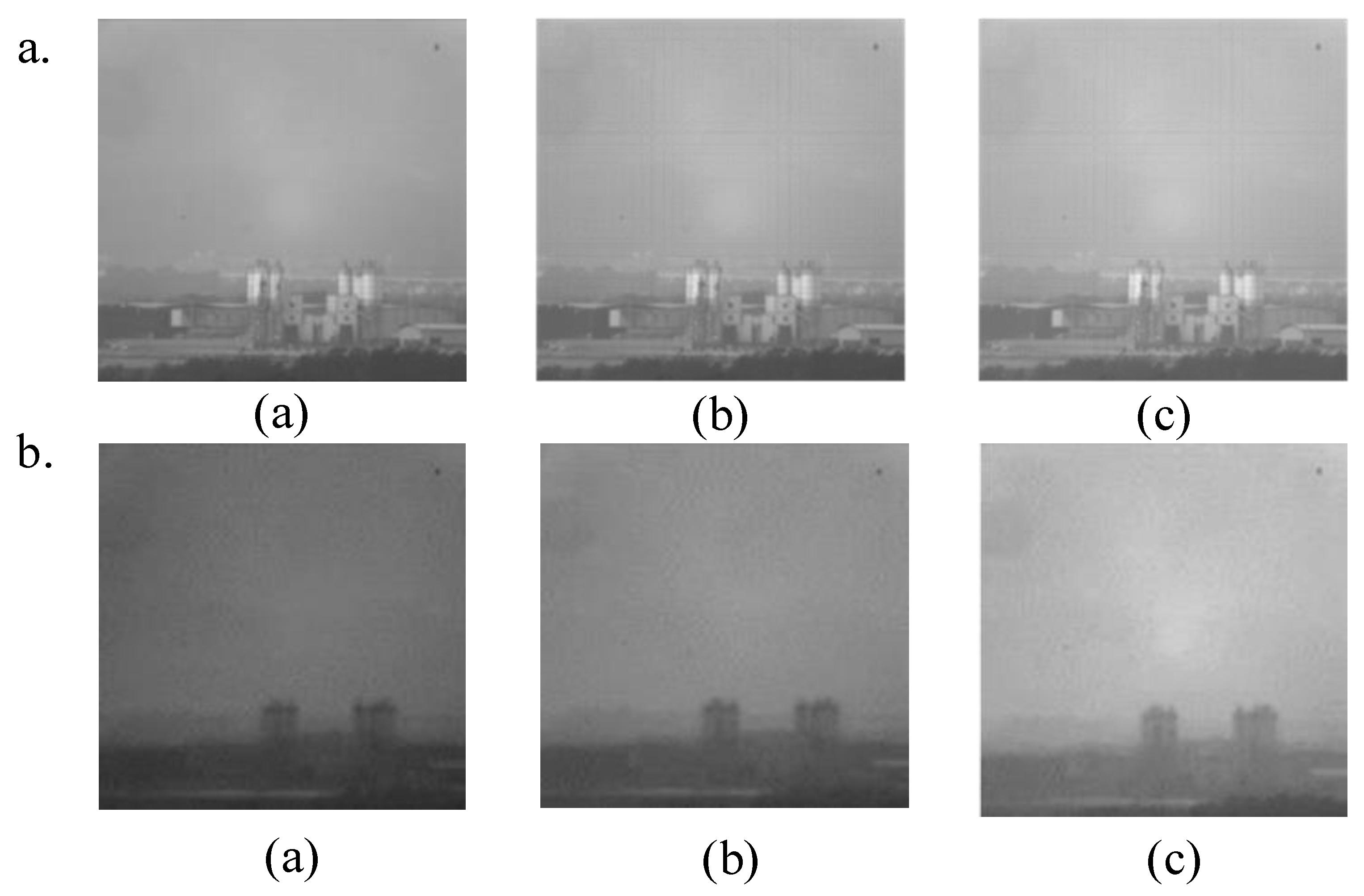Multi-Band Polarization Imaging in a Harsh Sea Fog Environment
Abstract
:1. Introduction
2. Multi-Band Polarization Imaging Principle
2.1. The Stokes Vector Method
2.2. Polarization Imaging Principle of Liquid Crystal Phase Retarder Method
2.3. LCVR Phase Delay Calibration
2.4. Polarization Image Evaluation Index
- (1)
- Subjective evaluation
- (2)
- Objective evaluation
- Information entropy (EN)
- b.
- Average gradient (AG)
- c.
- Standard deviation (STD)
3. Multi-Band Polarization Imaging Experiments
4. Experimental Results and Analysis
4.1. Analysis of the Effect of Multi-Band on Polarization Imaging
4.2. Analysis of the Effect of Optical Thickness on Polarization Imaging
5. Conclusions
Author Contributions
Funding
Institutional Review Board Statement
Informed Consent Statement
Data Availability Statement
Conflicts of Interest
References
- Vaughn, I.J.; Hoover, B.G. Noise reduction in a laser polarimeter based on discrete waveplate rotations. Opt. Express 2008, 16, 2091–2108. [Google Scholar] [CrossRef] [PubMed] [Green Version]
- Fu, X.; Mehta, Y.; Chen, Y.A.; Lei, L.; Zhu, L.; Barange, N.; Dong, Q.; Yin, S.; Mendes, J.; He, S.; et al. Directional Polarized Light Emission from Thin-Film Light-Emitting Diodes. Adv. Mater. 2021, 33, 2006801. [Google Scholar] [CrossRef] [PubMed]
- Kibis, O.V. Floquet theory of spin dynamics under circularly polarized light pulses. Phys. Rev. A 2022, 105, 043106. [Google Scholar] [CrossRef]
- Ling, M.; Song, M.; Hong, J.; Sun, X.; Tao, F. Optical design for simultaneous polarization imager based on off-axis three-mirror. Infrared Laser Eng. 2019, 48, 518001. [Google Scholar] [CrossRef]
- Fu, Q.; Luo, K.; Song, Y.; Zhang, M.; Zhang, S.; Zhan, J.; Duan, J.; Li, Y. Study of Sea Fog Environment Polarization Transmission Characteristics. Appl. Sci. 2022, 12, 8892. [Google Scholar] [CrossRef]
- Liang, J.; Ren, L.; Ju, H.; Zhang, W.; Qu, E. Polarimetric dehazing method for dense haze removal based on distribution analysis of angle of polarization. Opt. Express 2015, 23, 26146–26157. [Google Scholar] [CrossRef]
- El Ketara, M.; Breugnot, S. Imaging through haze using multispectral polarization imaging method. In Polarization: Measurement, Analysis, and Remote Sensing XIII; SPIE: Washington, DC, USA, 2018; Volume 10655, pp. 156–173. [Google Scholar]
- Zhang, X.; Zhang, Y.; Zhao, H.; Deng, H.Y.; Wang, Y. Research on long wave infrared imaging of sea target. In Eighth Symposium on Novel Photoelectronic Detection Technology and Applications; SPIE: Washington, DC, USA, 2022; Volume 12169, pp. 54–63. [Google Scholar]
- Guo, X.; Wan, J.; Liu, S.; Xu, M.; Sheng, H.; Yasir, M. A scSE-LinkNet Deep Learning Model for Daytime Sea Fog Detection. Remote Sens. 2021, 13, 5163. [Google Scholar] [CrossRef]
- KU, S.; Mahato, K.K.; Mazumder, N. Polarization-resolved Stokes-Mueller imaging: A review of technology and applications. Lasers Med. Sci. 2019, 34, 1283–1293. [Google Scholar] [CrossRef]
- Wang, B.; Dong, L.; Zhao, M.; Wu, H.; Ji, Y.; Xu, W. An infrared maritime target detection algorithm applicable to heavy sea fog. Infrared Phys. Technol. 2015, 71, 56–62. [Google Scholar] [CrossRef]
- Wang, Y.; Su, Y.; Sun, X.; Hao, X.; Liu, Y.; Zhao, X.; Li, H.; Zhang, X.; Ju, J.; Tian, J.; et al. Principle and Implementation of Stokes Vector Polarization Imaging Technology. Appl. Sci. 2022, 12, 6613. [Google Scholar] [CrossRef]
- Wu, Z.; Guo, L.; Zhu, M. The Image registration method combining Image information entropy and feature points. Infrared Laser Eng. 2013, 42, 2846–2852. [Google Scholar]
- Han, P.; Liu, F.; Wei, Y.; Shao, X. Optical correlation assists to enhance underwater polarization imaging performance. Opt. Lasers Eng. 2020, 134, 106256. [Google Scholar] [CrossRef]
- Bao, F. Research on Underwater Polarization Imaging and Image Processing Methods; Changchun University of Science & Technology: Changchun, China, 2019. [Google Scholar]
- Wang, W.; Chen, Z.; Yuan, X. Simple low-light image enhancement based on Weber-Fechner law in logarithmic space. Signal Process. Image Commun. 2022, 106, 116742. [Google Scholar] [CrossRef]
- Yao, L.; Gao, J.; Xiao, K.; Gong, Y. Theory and Testing Technique of Smoke; National Defence Industry Press: Beijing, China, 2004; pp. 37–41.
- Zhang, Y.; Gao, K.; Zhou, Y.; Hua, Z.; Han, L. Multi-polarization parameter target detection method based on modulation contrast. In Proceedings of the 2019 International Conference on Optical Instruments and Technology: Optoelectronic Imaging/Spectroscopy and Signal Processing Technology, Beijing, China, 26–28 October 2019; SPIE: Washington, DC, USA, 2020; Volume 11438, pp. 197–206. [Google Scholar]














| Evaluation Indicators | Change of Value | Evaluation Effect |
|---|---|---|
| EN | Increase | The more information the image contains |
| AG | Increase | The clearer the image |
| STD | Increase | Image fullness |
| Name | Parameters |
|---|---|
| Camera size | 80 mm × 80 mm × 100 mm |
| Resolution (pixels) | 1040 × 1040 |
| Frame rate at maximum resolution | 12 fps (12 bits), 20 fps (12 bits) |
| Digital | 8/12-bit grayscale imaging |
| Synchronous interface method | USB Interface |
| Spectral bandwidth | 410 nm~685 nm |
| Software | Version: Salsa 2.3.5 |
Disclaimer/Publisher’s Note: The statements, opinions and data contained in all publications are solely those of the individual author(s) and contributor(s) and not of MDPI and/or the editor(s). MDPI and/or the editor(s) disclaim responsibility for any injury to people or property resulting from any ideas, methods, instructions or products referred to in the content. |
© 2022 by the authors. Licensee MDPI, Basel, Switzerland. This article is an open access article distributed under the terms and conditions of the Creative Commons Attribution (CC BY) license (https://creativecommons.org/licenses/by/4.0/).
Share and Cite
Fu, Q.; Liu, N.; Guo, H.; Liu, X.; Yan, Y.; Geng, D.; Zhang, S.; Zhan, J.; Duan, J. Multi-Band Polarization Imaging in a Harsh Sea Fog Environment. Appl. Sci. 2023, 13, 202. https://doi.org/10.3390/app13010202
Fu Q, Liu N, Guo H, Liu X, Yan Y, Geng D, Zhang S, Zhan J, Duan J. Multi-Band Polarization Imaging in a Harsh Sea Fog Environment. Applied Sciences. 2023; 13(1):202. https://doi.org/10.3390/app13010202
Chicago/Turabian StyleFu, Qiang, Nan Liu, Hongrui Guo, Xuanwei Liu, Yujiaqi Yan, Dong Geng, Su Zhang, Juntong Zhan, and Jin Duan. 2023. "Multi-Band Polarization Imaging in a Harsh Sea Fog Environment" Applied Sciences 13, no. 1: 202. https://doi.org/10.3390/app13010202





